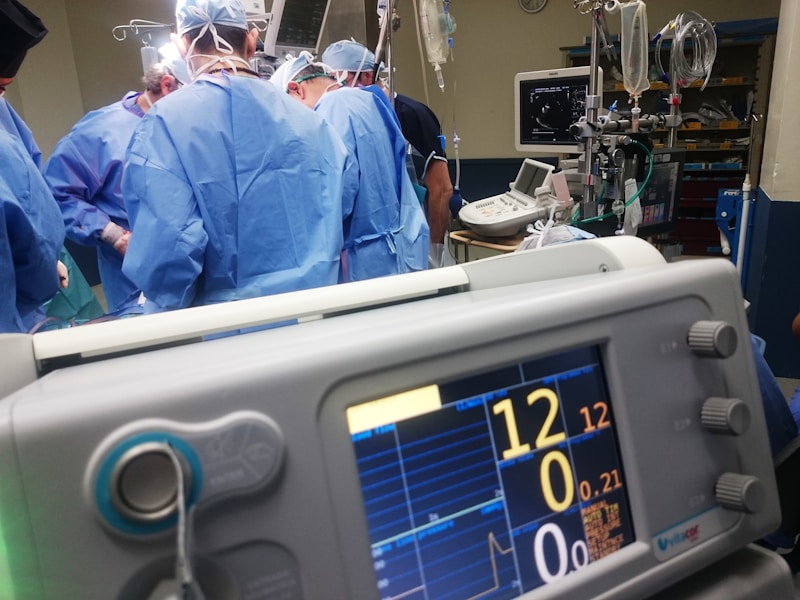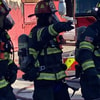Podcast Beta
Questions and Answers
What is the initial treatment for hypotension with a systolic blood pressure (SBP) less than 100?
What is the purpose of pre-oxygenation in the delayed sequence intubation process?
What medication and dosage is recommended for sedation in adults during the procedure?
In case of an inability to intubate on the first attempt, what is the next recommended step?
Signup and view all the answers
What is the appropriate dose of Rocuronium for adults if paralysis is not achieved after the initial administration?
Signup and view all the answers
What is the primary purpose of employing chemical sedation in emergency situations?
Signup and view all the answers
When should chemical sedation be considered according to the guidelines?
Signup and view all the answers
What should be done if physical access to the patient is unsafe for a vital sign assessment?
Signup and view all the answers
Which of the following is NOT required prior to administering chemical sedation?
Signup and view all the answers
What must be monitored once sedation is achieved?
Signup and view all the answers
Which is a crucial post-sedation procedure?
Signup and view all the answers
What important consideration must be made about the patient's position during restraint?
Signup and view all the answers
Who can EMS personnel consult for guidance regarding chemical sedation?
Signup and view all the answers
What position should restrained patients NOT be placed in?
Signup and view all the answers
What is the maximum single dose of Ketamine for pediatric patients experiencing severe pain?
Signup and view all the answers
Which of the following is the first line medication for pain management in adult patients?
Signup and view all the answers
What must be done before considering chemical restraint for pediatric patients?
Signup and view all the answers
How should Fentanyl be administered to adult patients experiencing pain?
Signup and view all the answers
What is the contraindication for administering Fentanyl to a pregnant patient?
Signup and view all the answers
What is the maximum total dose of Ketamine for adults undergoing severe pain management?
Signup and view all the answers
What is required for a patient to qualify for the Delayed Sequence Intubation protocol?
Signup and view all the answers
Which route should Ketamine NOT exceed when administered intranasally?
Signup and view all the answers
Which precaution must be taken when using Ketamine for patients with a history of opiate abuse?
Signup and view all the answers
For pediatric patients under 5 years old who may need Droperidol, what action should be taken?
Signup and view all the answers
What aspect of patient management takes precedence when dealing with possible chemical restraint?
Signup and view all the answers
After administering Ketamine intravenously, when should the pain scale be reassessed?
Signup and view all the answers
What is a primary indication for considering Delayed Sequence Intubation (DSI)?
Signup and view all the answers
What is the maximum total dose of Push-Dose Pressor Epinephrine that can be administered?
Signup and view all the answers
Which of the following is a contraindication for the use of Rocuronium in DSI?
Signup and view all the answers
How long should you wait before administering a second dose of Ketamine after performing DSI?
Signup and view all the answers
What is the recommended concentration of Ketamine for adult administration during DSI?
Signup and view all the answers
In cases of bradycardia during intubation after maximum dose of Ketamine, which medication should be considered?
Signup and view all the answers
What is a common precaution when administering Ketamine rapidly?
Signup and view all the answers
What should be monitored throughout the administration of Push-Dose Pressor Epinephrine?
Signup and view all the answers
What is the initial dosing for pediatric patients receiving Ketamine for DSI?
Signup and view all the answers
What is a critical component that must be used during the Delayed Sequence Intubation procedure?
Signup and view all the answers
What is the appropriate dose of Rocuronium for adult patients undergoing DSI?
Signup and view all the answers
Which condition is NOT an indication for Delayed Sequence Intubation?
Signup and view all the answers
What should be done if dissociation does not occur within 2 minutes of administering Ketamine?
Signup and view all the answers
How is the Push-Dose Pressor Epinephrine prepared?
Signup and view all the answers
Study Notes
Chemical Restraint
- Chemical sedation should be a last resort. The decision should be made by the EMS officer, independent of law enforcement influence.
-
Chemical restraint may be used in addition to physical restraint for the following reasons:
- Violent/Combative Patients: These patients pose a threat to themselves or EMS personnel.
- Agitated Behavior Patients: These patients exhibit bizarre and aggressive behavior, possibly due to drug use like cocaine, PCP, bath salts, Flakka, methamphetamines, and amphetamines.
- Law enforcement must first gain physical control of the patient before chemical restraint.
-
Special Considerations for Certain Populations:
- Patients over 65 years old
- Patients with Head Trauma
- Pregnant Patients
- Patients with a body temperature of 103 degrees Fahrenheit: Apply ice packs to the axilla (armpits) and groin area.
-
Drug Options for Adults:
- Cold Normal Saline: If available, administer 1L IV/IO and titrate to the desired effect. Monitor lung sounds and blood pressure (BP) frequently. May repeat once if needed. Exercise caution with patients with significant coronary heart disease, CHF, and renal failure.
- Sodium Bicarbonate: Administer 50 mEq IV/IO over 2 minutes.
-
Drug Options for Children:
- Chemical restraint should only be considered for children who show signs of puberty.
- Ketamine: Administer 3mg/kg IM/IN, with a maximum dose of 800mg. Intranasal route should not exceed 0.5mL per nostril and 1mL total.
- Versed: Administer 0.1mg/kg IV, IO, IM with Benadryl 1mg/kg IM or slow IV (diluted).
- Droperidol: Administer 0.1mg/kg IM for children between 5 years old and signs of puberty. Onset time is 5-10 minutes. Maximum single dose 5mg, maximum total dose 10mg. May repeat once if needed, in 15 minutes.
Pain Management
-
Fentanyl:
- Administer 100mcg IV/IO/IN/IM. May repeat twice if needed, at 5-minute intervals, with a maximum total dose of 300mcg.
- Contraindications include pregnancy near term (32 weeks or greater) or in active labor.
- Precautions include a history of opiate abuse or drug-seeking behavior. Monitor patients for respiratory depression and discontinue if they become drowsy.
-
Ketamine for Severe Pain (Pain Scale 7 or Higher):
- Dilute 50mg (1mL) of Ketamine in a 100mL bag of D5W.
- Administer 25mg (50mL) IV/IO over 10 minutes. Reassess pain scale after half of the infusion has been administered.
- May repeat once if needed, with a maximum total dose of 50mg (100mL).
- Also available for intranasal or intramuscular administration, with a maximum dose of 75mg.
Delayed Sequence Intubation (DSI)
-
DSI is indicated when a patient requires aggressive airway management and meets one of the following conditions:
- Failure to ventilate or oxygenate spontaneously (excluding foreign body airway obstruction)
- Failure to maintain airway patency
- Rapid deterioration of clinical presentation.
-
Indications for DSI, but not limited to:
- Failure to protect from aspiration and protect airway
- Trauma patients who require aggressive airway management
- Respiratory exhaustion such as severe asthma, CHF, or COPD with hypoxia and refractory to initial treatments
- Overdose with altered mental status where the loss of airway is inevitable
- Swelling of upper airway such as anaphylaxis, angio-neurotic edema, and super-heated gas inhalation
- Closed head injury
- Trismus (Lock-Jaw) or clenched teeth
- Status epilepticus
- Cyanide and carbon monoxide toxicity where loss of airway is inevitable
- Burn patients with airway involvement and inevitable loss of airway patency
DSI Checklist
- The DSI checklist is mandatory during the procedure.
- Initiation of the DSI protocol allows for a 10-minute delay in transport.
DSI: Pre-Medication
- All patients require a systolic blood pressure of at least 100 mmHg before paralytic administration. This is to prevent peri-intubation arrest, as paralysis removes negative pressure in the airway.
DSI: Hypotension (Non-Traumatic)
-
Push-Dose Pressor Epinephrine (1:100,000):
- Dilute 9mL of Epinephrine 1:10,000 with 9mL of normal saline to create a 1:100,000 concentration, resulting in 10mcg/mL.
- Administer 1mL/minute IV/IO, titrate to maintain age-appropriate SBP
- May repeat once if needed, with a maximum total dose of 0.2mg (20mL)
- Contraindications include hypotension secondary to blood loss. The exception is in DSI after fluids are ineffective.
- Precautions: Do not administer faster than 1mL/minute. Monitor heart rate and blood pressure throughout administration.
DSI: Paralytic
-
Rocuronium:
- Adult: Administer 100mg (10mL) IVP/IO. Wait 90 seconds for full effect. If paralysis is not achieved, administer an additional 50mg IV/IO.
- Pediatric: Administer 1mg/kg IVP/IO. Refer to Handtevy.
-
Contraindications:
- Hypersensitivity/allergy to Rocuronium or other neuromuscular blocking agents
- Acute asthma exacerbation
- Major facial or laryngeal trauma
- Patient who cannot be assisted with a bag-valve-mask
DSI: Post Intubation
- After 15-20 minutes, administer a second dose of Ketamine.
- If Ketamine is unavailable, sedate with Fentanyl.
- For children under 2 years old, administer 0.02 mg/kg of Atropine after Ketamine.
DSI: Complications
-
Documentation is critical and should include:
- Time of Ketamine and Rocuronium administration
- Time of intubation
- Time of initial EtCO2
- Continuous EtCO2 values
- EtCO2 value upon transfer of care.
- Match pre-intubation respiratory rate if it is rapid.
- High flow O2 and bag-valve-mask ventilations may be required.
- Consider advanced airway procedures, including cricothyrotomy.
DSI: Hypersalivation Reaction from Ketamine Administration
-
Atropine:
- Administer 0.5mg IV/IO. May repeat if needed, at 3-minute intervals, with a maximum total dose of 3mg.
- Contraindication: Bradycardia in the presence of a myocardial infarction (MI).
DSI: Max Dose of Ketamine Administration
-
If the Patient begins to wake up:
- Versed: Administer 5mg IV/IO (may repeat once, at 5 minutes, with a maximum total dose of 10mg). Also available for intramuscular or intranasal administration (10mg).
- Obtain a temperature.
Studying That Suits You
Use AI to generate personalized quizzes and flashcards to suit your learning preferences.
Description
This quiz covers the essential guidelines for the use of chemical restraint in emergency medical services. It emphasizes when to use chemical sedation, considerations for various patient populations, and the necessary conditions for its application. Understand the protocols necessary to ensure safety for both the patients and EMS personnel.





